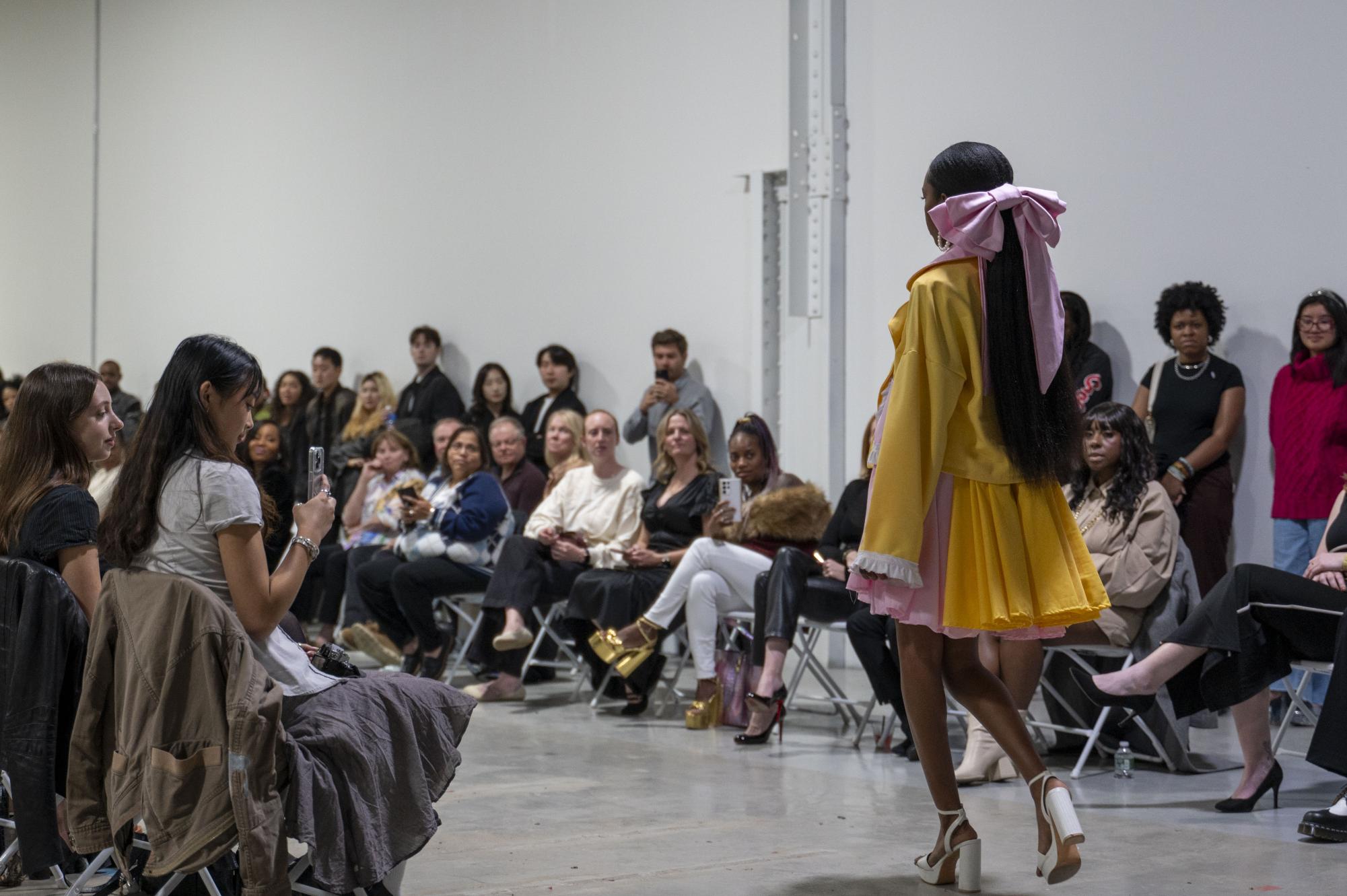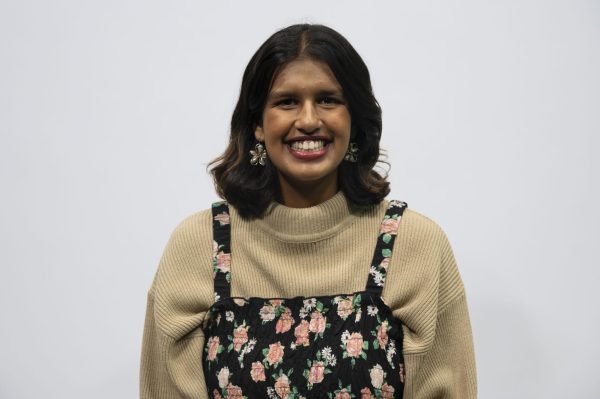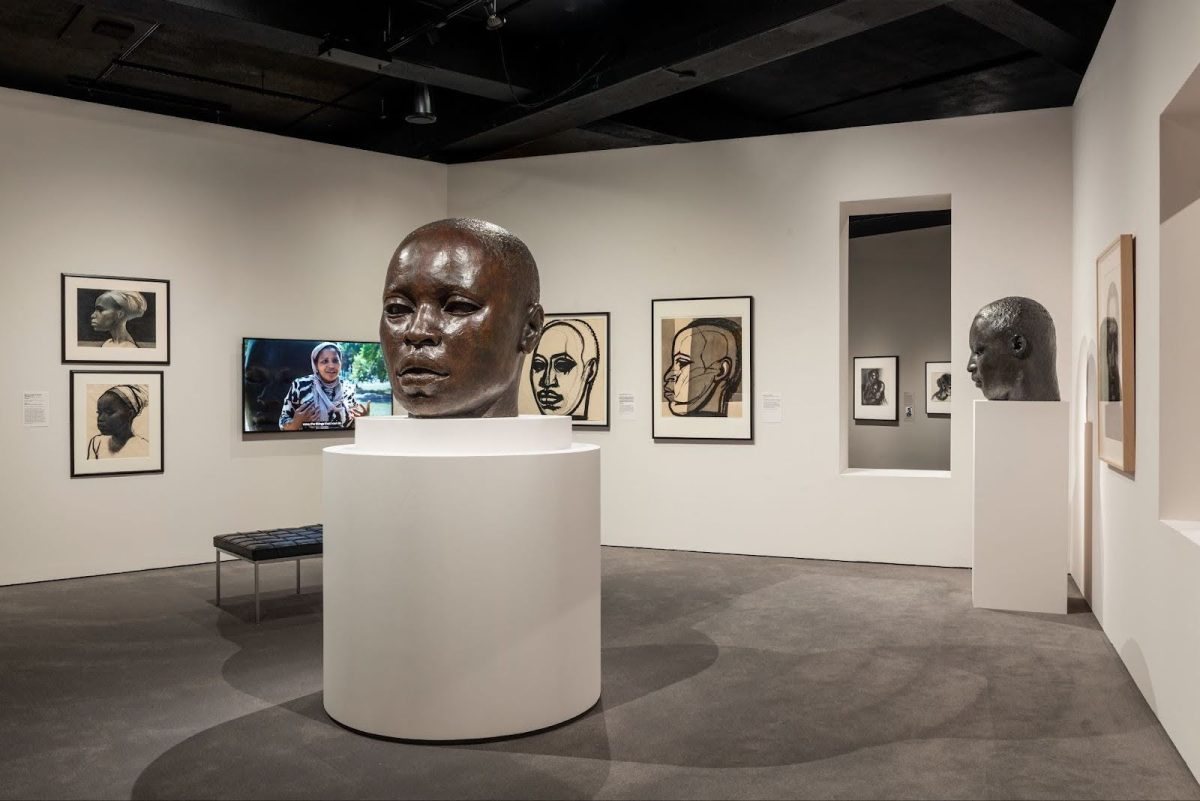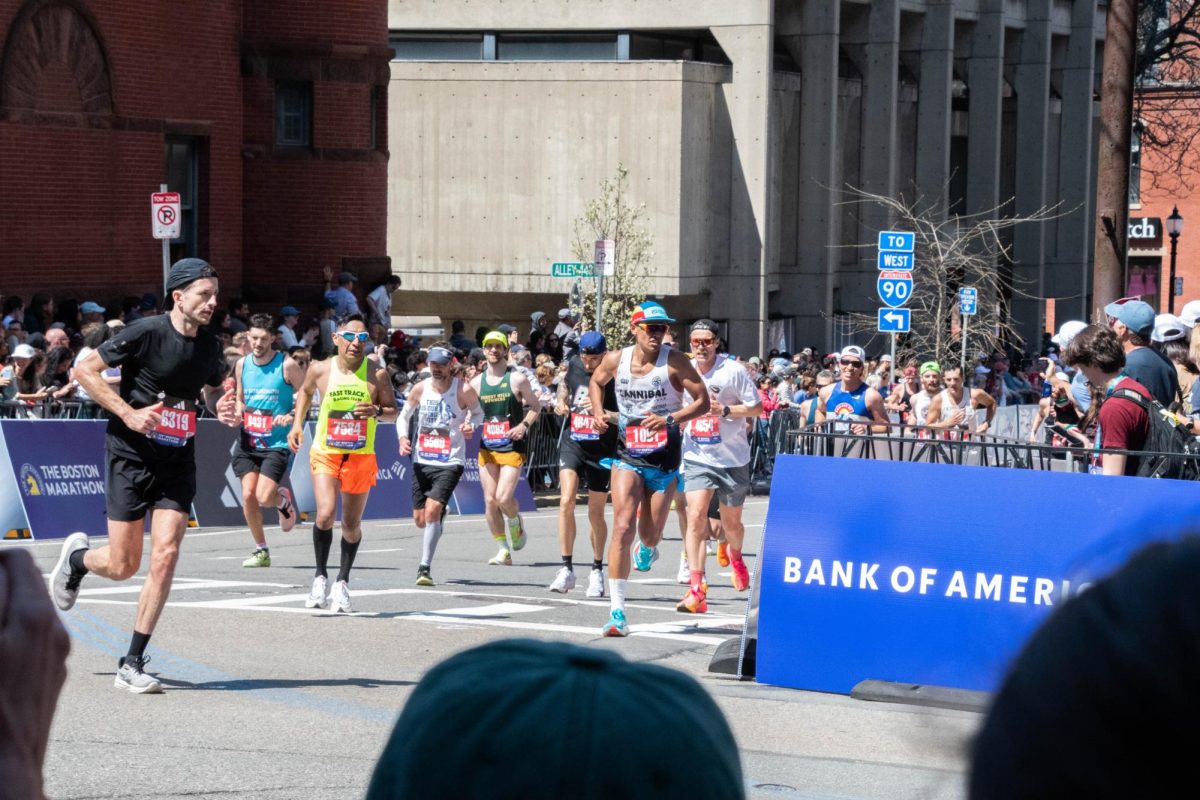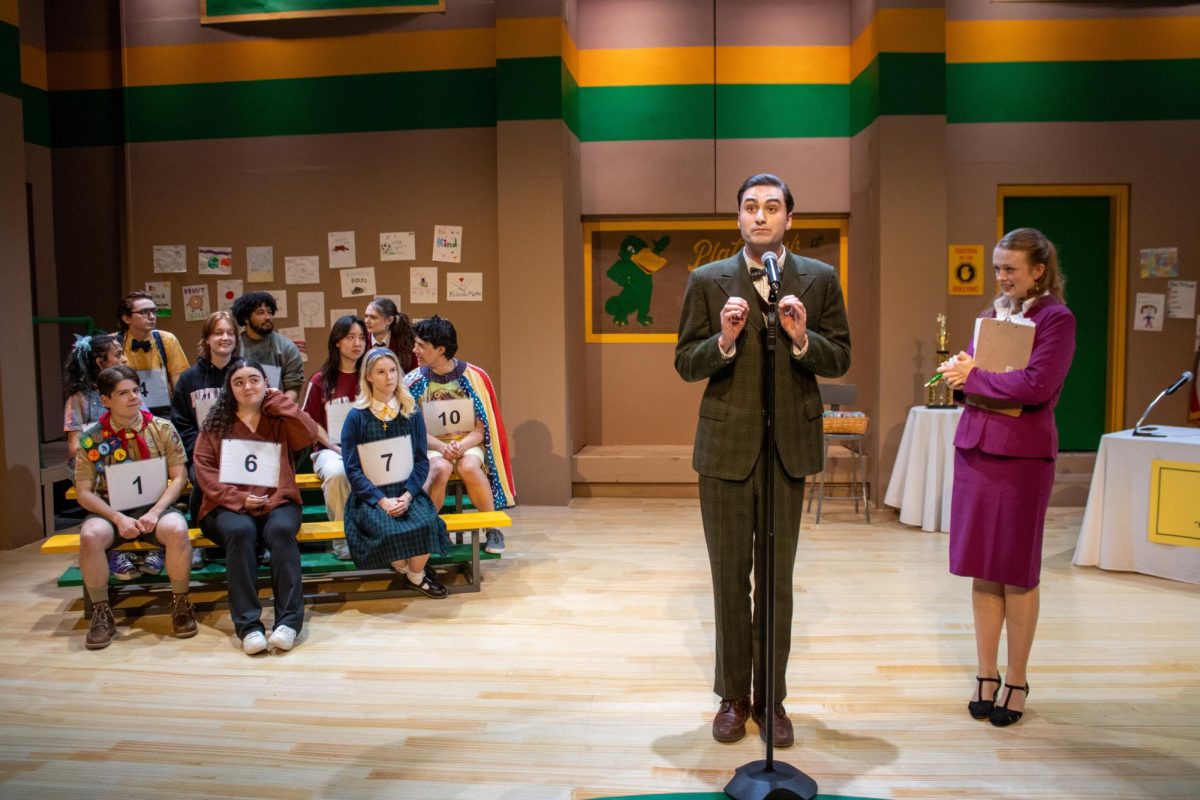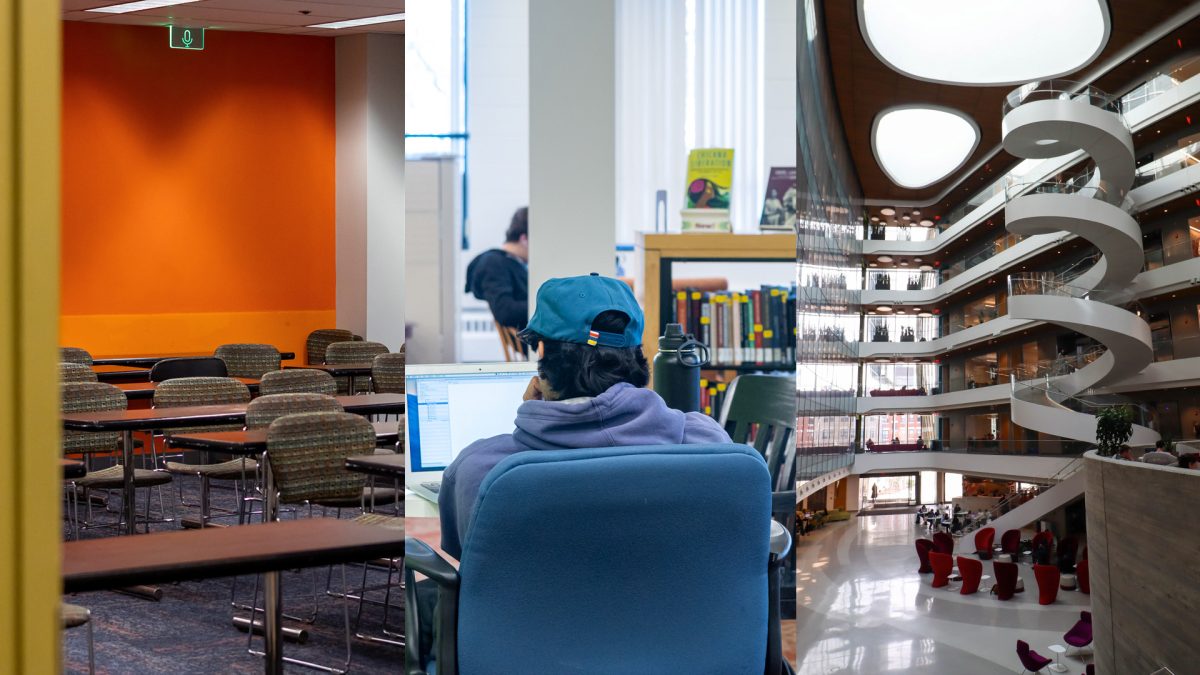For those in search of 3D-printed breastplates, burnt sustainable blazers or giant, cotton-ruched hoods, look no further than House Fashion Week’s third season. A precursor of Boston Fashion Week, over four days from Oct. 9 to 12, House Fashion Week allowed young designers to exhibit their latest collections to the general public at displays around Boston. Each day was dedicated to amplifying local and international voices, giving artists the opportunity to highlight their innovative clothing.
Museum Installation
The first official night of House Fashion Week began at the M Fine Arts Galerie in the hip SoWa Art and Design District Oct. 9. The installation began with an introduction by David Jean, the executive producer of House Fashion Week, who was joined by Aryn Lovell, who designed the first collection shown. There was no official runway — instead, models stood in various corners of the art-filled room.
Lovell earned a degree in mechanical engineering from Virginia Tech in 2024 before transitioning to the fashion industry. She brings her expertise in computational structuring with her 3D-printed breastplates and unique silhouettes under her label, LOVELLI. Her collection, which consisted of long, silky skirts, bikini-style breastplates and asymmetrical linings, was all in black and white, a nod to her inspiration: the ballet “Swan Lake.”
“I grew up around ballet and ‘Swan Lake’ was my favorite,” Lovell said. “So this idea came from the white swan and the black swan. The black swan is portrayed as very alluring [and] sexy, and then the white swan [is] very pure and innocent. I think women can be both sexy, alluring and also very pure and innocent.”
K Kim, designer of label KHK, focused his pieces on more structured designs and darker colors, with careful emphasis on the pleating of skirts and ties or zippers that kept cropped, blazer-like tops together.
“It’s about representing the uncomfortable atmosphere of myself,” Kim said. “I thought I was uncomfortable because I wasn’t really into any kind of community.” The suffocation of self Kim spoke of is evident in the tightness of the clothing and the usage of different shades of gray.
The fourth designer was Jacqueline Mones for her label JACQUELABEL, which has a large social media fan base due to her iconic butterfly tops having previously gone viral on Instagram and TikTok. Mones graduated from the Massachusetts College of Art and Design and specializes in textile innovation, which can be seen through her fairytale-like breastplates.
“I want to design something that when you walk into a room, people will look at you,” Mones said. The different shades of pink and hints of green, coupled with the almost plastic-like, yet seemingly flowy nature of each butterfly wing top, display Mones’ unique talents.

Kay Wan’s collection Beyond Boundary Beyond Uniform challenged the boundaries of fashion fusion with her sporty-structured collection. Inspired by the uniforms she wore growing up in China and the intricacies of American sportswear, Wan’s pieces are foamy, protective pads with mesh netting, jersey numbers and accessories such as a plush football bag. Each design significantly alters both the looseness of American sports gear and the rigidity of school uniforms, ultimately creating an aesthetically fascinating blend of puffed-out shoulder pads and skin-tight blue leggings.
The final collection, Laurel Blue, created by Parsons and Central Saint Martins graduate Laurel Fang, illustrates the relationship between humans and the sea. This was Fang’s first menswear-only collection, and each article of clothing highlighted her intricate color style and baggy silhouettes.
“I started making this Laurel Blue collection in 2022, so the ocean scene has always been quite consistent,” Fang said. She creates and dyes each piece of clothing herself, using a technique involving an ice cube and pigment.
Marina Greaney, a student at Middlesex Community College attending the event on a class field trip, enjoyed each collection and getting to experience the Boston fashion scene.
“I have never been to anything fashion-related before, and I love this,” Greaney said. “I love the older model in particular, just her making statements left and right with the clothes.”
The older model she referred to, Janine Myers, said she realized “there weren’t enough older women on the runway” and decided to try runway modeling after having done lifestyle modeling for the past three years.
“It kind of takes you out of yourself. And the group of people that you meet every time you come to a runway show, it’s a phenomenal experience,” Myers said.
The Collective
Day two of House Fashion Week was a runway-style showing of nine different designers’ collections in a warehouse-style studio on Sprague Street in Readville.
The shows began with Nathalia JMag’s brightly colored, coquette-like collection. Castrillon specializes in creating sustainable clothing made from materials like bamboo, organic cotton, linen and upcycled garments found in landfills. Her collection was filled with yellow bow-shaped tops, structured yellow blazers on tops of ruffly pink dresses and dramatic white lining around form-fitting skirts.
Next, Nathan Domingos, with his label MINTED SUPPLY, exhibited his two-part collection. The first half, with military-green, sharp blazers and pants with “dollar bills” made of fabric pouring out of the sides, represented his streetwear style, while the second half consisted of burnt and shredded sleeves made of sustainable material. The Boston-based designer created powerful, assertive pieces with a play on masculine structures.
Drawing from nautical influences, Lillian Pexton brought viewers on a trip under the sea with her collection from her brand Princess Chicken. Bright blues representing different ocean shades and dashes of yellows, reds and pinks from the ocean’s coral and wildlife made their path down the runway. The final piece embodied a jellyfish, with a dome shape of white and blue fabric crackling as the model walked as free-flowingly as the underwater creature.

Elliot H X Jia’s collection was a constrictive piece of performance art. Large hoods of fabric encased a model’s head, white fabric was wrapped around the shoulders of another and a coat transfigured an almost sphere shape around the knees. Jia, who has immense experience in craftsmanship and fine tailoring, studies the socio-history of the world and attempts to bring that knowledge into his clothing.
Another label, 3NDOLITH, was inspired by endolith organisms that can adapt to any extreme environment. The 3NDOLITH collection, in turn, aims to create pieces that last just as long as the organisms. Using post-consumer recycled material, each article of clothing was compelling and somewhat post-apocalyptic. Several models wore mesh masks covering their faces, with fabric outlining the mask that matches the actual garment. With translucent, thin pieces of material flowing out to create multi-layer pants and smartly draped fabric contorting around the body, the stand-out piece was the final dress, which embodied a sea creature swimming around.
The final collection, by Hyunho Ki under his label NUYH NEWYORK, was a series of mostly black menswear ensembles rooted in the theme of how clothing creates a person’s first impression. Black sweaters and tight pants with slits around the ankles composed his dark, moody collection, with clean lines which showed his construction skills.
The Main Show
The final day of House Fashion Week commenced Oct. 12. Initially, each of the five designers were meant to get a full hour to debut their collections. However, after timing issues and scheduling complications, two of the designers exhibited their runway shows in the afternoon, and the remaining three ran in the evening. The News was able to capture the final three collections.
Featured in Vogue Runway, Alessia Aucoin showcased pieces inspired by hiking and climbing gear for her label CYCLD. Influenced by her upbringing in Canada and the connections between the North and South Pole, her neutral-colored clothing takes a trip to the coldest parts of the world. Most of her pieces involve an intricate ruching of some kind, either through dramatic bunching in one spot or subtle gatherings of fabric throughout the garment. Her collection featured long coats, short dresses and sweater-and-pant ensembles, all embodying the idea of warmth and femininity.
Victoria Stewartbaxter’s collection for her label Vo Stewartbaxter showcased her shiny, edgy and performative style on the runway. Stewartbaxter previously has dressed celebrities like Rebecca Black, and her pieces take inspiration from punk-rock glam and deep, pigmented colors. Her collection involved feathered headpieces, spikes coming out of the fabric of dresses and shiny material tightly wrapped around the body. A few of her pieces utilized loose, lace-based fabric, a contrast to her other, sharper designs that relied on form-fitting, tight material.
The final collection, created by Zonya Campbell, was a skillful display of elegant dressmaking and the art of wedding dress creation. The first half of Campbell’s collection displayed floor-length gowns, often paired with some kind of jeweled element — either a bedazzled bodice or a simple, multi-layer necklace-style piece. Each dress nearly perfectly contorted around the model wearing it, further emphasizing Campbell’s artistry. The wedding dresses had playful sleeves or elaborate ruching across the shoulders and were both sophisticated and fun at the same time.
Despite some minor timing issues, the three-day saga of House Fashion Week allowed fashion fans and general clothing enjoyers the opportunity to witness collections created by young, innovative designers. Each event was not only a chance for artists to display their high levels of technique in modern fashion, but also created an environment for the city of Boston to highlight its own vibrant fashion scene and make a name for itself amongst the fashion capitals of the country.
